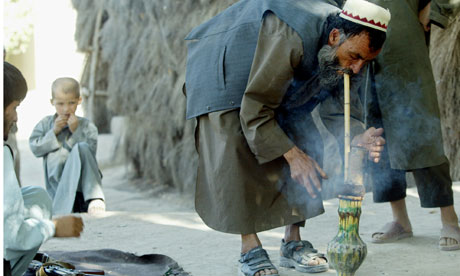cannabis cultivation
 More Afghan families turn to cannabis cultivation
More Afghan families turn to cannabis cultivation
High crop prices fuel increase in number of growers, adding to drug-control problems in world leader for opium production.
Emma Graham-Harrison in Kabul – Monday 8 October 2012 10.35 EDT
An Afghan farmer smokes hashish Photograph: Mindaugas Kulbis
The number of Afghan families growing cannabis as a cash crop leapt by more than a third last year, the UN has said.
The increase adds to the drug-control problem in a country that is already the world’s top producer of opium.
Prices for the best quality resin have nearly tripled since 2009, to $95 (£60) a kilogramme, adding to the lure of a crop that can earn farmers more than opium poppies. It is also is generally looked on more leniently by authorities targeting drug crops.
As a result, Afghanistan’s importance as a source of cannabis resin for world markets may be growing, the report warns, as other producers, such as Morocco, are producing a smaller share.
Afghan farmers were expected to produce around 1,300 tonnes of cannabis in 2011, the Afghanistan cannabis survey estimated. That is a similar amount to the previous two years, but with many more farmers turning to the crop.
Jean-Luc Lemahieu, the head of the UNODC office in Afghanistan, said: “It is clear that while the domestic consumption is very high, it does not nearly cover the 1,300 tons produced during 2011. The export of cannabis is thus a significant economic life line.”
Around 65,000 households grew cannabis in 2011, compared with 47,000 the year before, its said. The survey omits “kitchen garden” growers, who cultivate a handful of plants for themselves or to sell locally: these are believed to produce a tiny fraction of the national crop.
“The cannabis price rise has developed in parallel with the opium price hike caused by the opium crop failure in 2010, making its per-hectare income similar to that of opium and thus financially very attractive to farmers,” the UN report said.
“But because cannabis cultivation is less labour intensive – less weeding is involved and the extraction of ‘garda’ (powdered cannabis resin) can be done at home in a matter of weeks with the help of family members instead of hired labour – it is actually more cost-effective than opium.”
Unlike opium, which matures rapidly and needs little irrigation, cannabis is a water-intensive crop that needs a long time to grow, prohibiting the planting of another crop. Partly for this reason, farmers tend to grow the plant on a sporadic basis rather than every year.
But the two illicit crops often coexist, with the centre of cannabis cultivation shifting from the north to the opium poppy heartland in the south over the last five years, the report said.
“There is a clear geographical association between opium and cannabis cultivation at the provincial level,” the report said. “That association exists at a household level, too, with almost two thirds of cannabis-growing households (58%) also reporting poppy cultivation in the preceding season.”
Three-quarters of farmers said they grew the crop because of high sales prices; the 2011 crop was worth around $95m, the UN estimated, although this was less than the 2010 crop. That year, a larger crop was produced, but by fewer households.
Click Here for guardian.co.uk/world/2012/oct/08/afghan-families-cannabis-cultivation-opium
